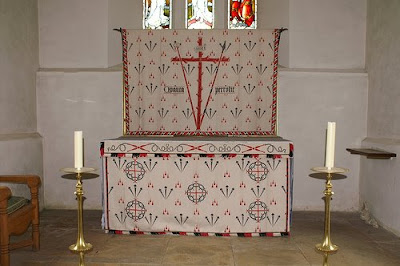Alas, not for 2009 but seventy years ago in 1939 when some of the more unpleasant revisions were still a decade and a half away.
This notice, taken from the April 1st edition of 'The Tablet', does not list all the Hours. The standard practice at the Cathedral in 'better days' was to have Prime and Terce at 10:10, Capitular High Mass at 10:30 followed by Sext and None. Vespers, outside of Lent, at 15:15 followed by Compline and finally Mattins and Lauds at 18:00. When the Cardinal Archbishop pontificated Terce or None was sung in a side chapel at 10:00. When two High Masses were required Prime began at 10:00.
The Lenten practice of following Mass with Vespers can be observed in the entry for Spy Wednesday but note Compline followed by Tenebrae (Mattins and Lauds) in the late afternoon.
Clearly an early start was planned for Maundy Thursday for the Consecration of the Holy Oils, procession to the altar of repose etc. Vespers are not mentioned but I believe it safe to assume they would have been recited by the Canons whilst the Cardinal devested and before the stripping of the altar. The Mandatum took place in the afternoon again celebrated by the Cardinal. Compline and Tenebrae again in the late afternoon. After Tenebrae the Ceremonial washing of the altar took place. A mixture of wine and water is poured onto the altar and brushes and towels used to clean the mensa. The service involves the bishop, if present, canons and beneficiati each in hierarchical order cleaning the altar whilst the antiphon Diviserunt and psalm 21 (as used at the earlier stripping of the altar) are chanted. At the end of the service the Miserere is chanted in a low voice followed by the collect Respice.
On Good Friday an auxillary bishop pontificates coram Cardinali. I believe it safe to assume that Vespers would have been monotoned after the Pre-Sanctified liturgy along with the Little Hours beforehand. Again Compline and Tenebrae in the late afternoon.
On Holy Saturday again an early start for a Pontifical blessing of fire etc. The Cardinal then 'took over' for Mass with its interpolated Vespers. (The Ordinary could do this, a priest celebrant had to celebrate the entire ceremony himself). Again late afternoon Compline followed by perhaps the most important, and often most neglected, service of the Liturgical Year Mattins and Lauds of Pascha with the triumpal invitatory Surrexit Dominus vere, Alleluia - The lord is truly risen, Alleluia. In many Medieval rites immediately prior to Paschal Mattins was the time when the images were unveiled and the array removed.
I suspect contemporary services are somewhat diminished.

















